Last week I wrote about a Amida-in which is a Buddhist Temple. This week we’ll visit a Shinto Shrine called Sugawara-jinja. Jinja is one of the suffixes denoting a shrine and has nothing to do with black-clad Japanese assassins appearing from inside magic lamps. Other suffixes that indicate a shrine include -gu, -jingu, and -sha. Shrines appear on Japanese maps as a stylized torii gate. For karmic balance, I’d better tell you the suffixes for Buddhist temples. They include -in, -ji, -tera, and -dera, and are shown on maps as a swastika.
Sugawara Shrine, or Sugawara-jinja, is about a ten-minute walk from our apartment. As can be expected, it’s on a hill, but if you choose your route carefully it’s relatively painless to get there. From what I can tell, it’s a minor shrine, famous for the person it was built in honour of.
There’s a sign on the shrine grounds, in Japanese and English. Shrine grounds. It sounds like the residue of some special, deirrific drink. Which is interesting due to the fact that people come to Sugawara shrine not only to pray, but to get water from the spring. It’s said to be especially good for making tea. Regarding the sign, rather than typing it verbatim, I’ve made a few corrections without changing the basic meaning. Sorry, no encrypted English today. Here’s what the sign says, more or less:
Sugawara Shrine
In 901 (beginning of Engi), Sugawara Michizane was appointed mayor of Dazaifu. On his way to his new post he stopped off at Tobata’s Tenrai Temple.
Many years later in Dazaifu a mausoleum was built in memory of Sugawara. Since he had visited the Tenrai Temple, it was decided to dedicate a shrine to him there.
Fukuoka Prefecture has a number of historic shrines. Munakata Taisha, about halfway between Kitakyushu and Fukouka City, is supposedly the oldest of Japans 6,000 or so shrines. Dazaifu Tenmangu, in the same Dazaifu quoted above, is the primary, or “home” shrine for the education gods. As such it’s a major destination for students, especially right before entrance exams. Dazaifu is also host to the Omoshiroichi flea market and Komyozenji, a temple with a beautiful zen garden. These two highlights make Dazaifu one of Lia’s favourite places in Japan. But that’s a topic for one or more future posts.
If you have a decent memory for the random bits of Japanese I drop into these stories, you may recognize the name Tenrai Temple, more commonly known as Tenrai-ji (天籟寺). It’s the name of the neighbourhood elementary school Jarrod attends.
Every year there’s a big festival in Tobata called Tobata Gion Oyamakasa. In the days leading up to it, someone hangs strings of paper lanterns at each of the participating shrines. I’ll be writing about it in the near future as I’ve got some really nice photos to show off. Here’s a view up the stairs to Sugawara Shrine, with many lanterns and two gates, or torii. I took the photo on July 3, 2004.
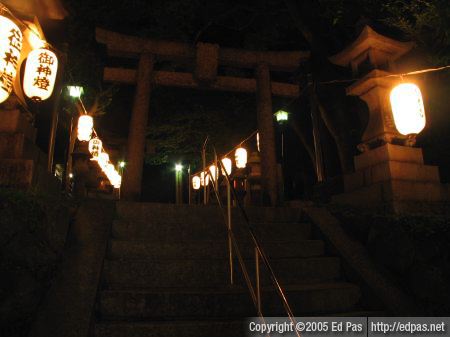
The rest of these photos, except for the final one, are from last Saturday, April 23, 2005. Here’s a view of a young boy climbing up the same stairs pictured above. That’s the late afternoon sun, so I’d guess that the shrine faces east.

And here’s the opposite view: looking down through the three torii and down the stairs. I was standing on one of the lower steps of the shrine building for this shot.

On the north side of the main shrine building are a number of small altars. There are three plain stone ones, and two wooden ones that are painted red.

Here’s a closeup of the two wooden altars.
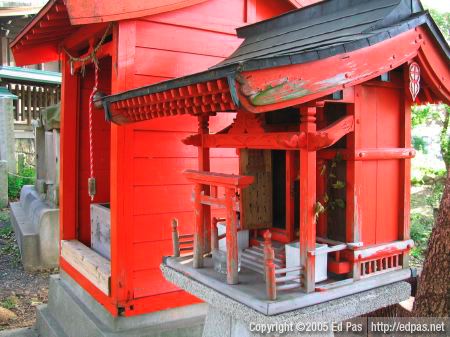
A peek inside the larger one:
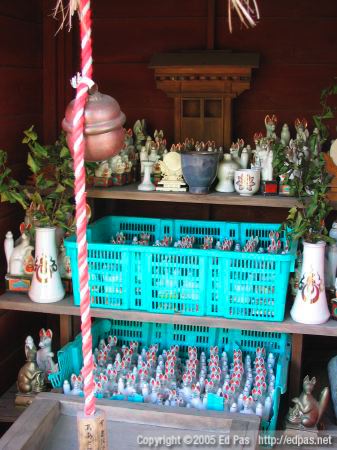
And a detail of one of the baskets full of ceramic fox figurines:
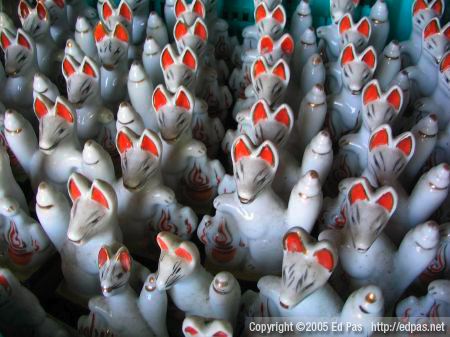
I don’t have any decent pictures of the main shrine building, but here’s the best one from my photo expedition on Saturday. This is the building as viewed from the northeast, so the small altars are to my right.

Finally, a photo of the front of the shrine, taken on a snowy night in January 2004:
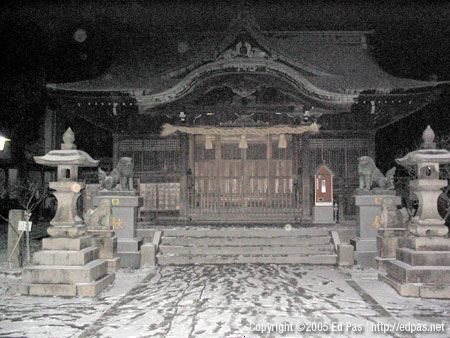
Interesting that you should visit this shrine that was named for this Sugawara person – he is an ancestor on my mother’s side of the family. Her father’s family, Tobimatsu, had large tracts of land in the interior of Kyushu. Of course, with the reforms of the last century, most of it’s gone. What was left went to her father’s nephew (because my grandfather had 5 daughters and no sons, so it went to the next male in line).
I find it fascinating that we are uncovering so many ‘coincidences’ in our respective lives and experiences. Really enjoying your updates Ed! Hugs to Lia and Jarrod.
Margaret
What’s even more interesting is that it just happens to be our neighbourhood shinto shrine! About a 10 minute walk from our apartment 🙂
Japan.guide.com reports that foxes are thought to be messengers of Inari, the Shinto god of rice. This raises more questions. Would this little shrine be a shrine to Inari? Does each little shrine honour some specific deity? Are the happy little snakes in honour of someone?
This morning I had a brief conversation about the foxes with one of the teachers at my school. She told me that the little white ceramic figures (foxes and snakes) are a kind of spirit messenger, and also sometimes revered as gods/spirits in and of themselves. She also said something about their messages not always being happy, and that the general view of these spirits is not positive. The altar may be to appease them and avoid bad luck.
I found this extensive writeup about Inari. There are further links at the bottom of that page. And wikipedia has what at first glance appears to be a decent overview of Shinto beliefs.
I wonder if there’s a link between Japanese shrine foxes and the rampant superstitions about fox spirits in China at the end of the Qing dynasty. This theme shows up to this day in Hong Kong Kung fu period films where fox spirits manifest as beautiful young women wearing robes with long white sleeves and twirling around in the air with otherworldly speed and accuracy.
Any young kung-fu/video game types worshiping these foxes?
I don’t think it’s quite the same thing. Foxes are considered supernatural here, but from what I’ve been able to find out—which admittedly is not much—they’re something to be feared rather revered.
Your first respondent, Margaret, is related to me via Sugawara Michizane whose shrine is hereinabove depicted. Wonder how much of the genealogy she knows. Michizane was only the third generation to have that name from about 20 B.C. to 781 A.D. our name was Haji (or Hanishi) and before that, Nomi. Nomi no Sukune is said to have fought using atemi, that developed into both jujutsu and sumo. There are few shrines that honor him as well. According to the Nihongi (chronicles) the Nomi claimed descent from the god Amenohohinomikoto. So it you are a follower of Shinto you have three gods in your lineage. I don’t believe in this; I am a Lutheran pastor.